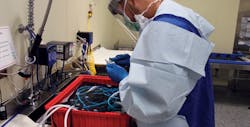It’s a constant struggle — the need for central sterile/sterile processing department (CS/SPD) professionals to keep up with the operating room’s (ORs) demand for safe and effective surgical instruments. Many factors add to the complexity of this challenge, including lack of communication/coordination between the CS/SPD and OR, variability in processes, inadequate instrument inventory, poor inventory tracking, and insufficient equipment and staff resources.
CS/SPD departments that have successfully improved their reprocessing turnover shared the practices, tools and services they use to achieve their goals. New products that can help boost reprocessing efficiency are also featured.
Break down silos
Jim Stanicki, Enterprise Manager of Sterile Processing for Cleveland Clinic, has been with the medical center for nearly 30 years. One of his more recent initiatives has been to develop a unified approach to reprocessing where all parties to the process — CS/SPD, OR, Surgical Supply, OR Support Services and Nursing — work collaboratively to make improvements.
“For many years we were working in silos, which led to finger pointing when problems occurred,” said Stanicki. “One thing that we struggled with was instrument turnover times. OR would say to CS/SPD, ‘I dropped this tray off to you a half hour ago, why isn’t it done?’ To overcome this, we decided that we all needed to gain a better understanding of each other’s worlds. Many of our efforts forced individuals to leave their comfort zones but as a result, they became open minded and we successfully broke down barriers between departments.”
These efforts included monthly business review meetings where stakeholders came together to share what was happening in their departments. They also engaged in “town hall” meetings where each department performed a presentation or acted in a skit to highlight an element of their work.
To specifically address the challenge of instrument turnover, Stanicki came up with the idea to create a video where CS/SPD and OR staff, including the OR director, chief of orthopedics and key administrators, acted out each step in reprocessing. Working together they wrote a script that captured all of the facets that go into reprocessing to help demonstrate factors that impacted turnaround times — from CS/SPD to the OR and back to CS/SPD again.
“We had a lot of fun making the video, which was humorous in nature but communicated some important lessons on turnover time and brought us all closer together,” said Stanicki. “Coming out of that project we learned to work out the details instead of assigning blame when something went wrong. We held OR/SPD collaboration meetings (with each service) where we would all sit down and go over the issues we were having and collectively figure out what are the opportunities to make improvements. We’ve continued to make improvements as procedures and products change to avoid new problems from developing.”
Working together, the CS/SPD and OR nursing staff tackled the challenge of unused instruments. They found the CS/SPD was spending significant time and effort inspecting and cleaning instruments that went unused during cases. They engaged in a service specific consolidation effort where they consolidated three separate trays (basic laparoscopy, basic general surgery and mini laparoscopy) into a single, standardized general surgery tray containing 117 instruments, a 52 percent reduction in instrumentation.
Stanicki now meets with CS/SPD directors at other healthcare organizations that are struggling with reprocessing turnover times to share his experiences and best practices. His advice to others facing this challenge:
“Stress and rushing make it more difficult for everyone. If you take the time to understand each other’s roles, you have a better respect for what others are trying to accomplish. You need to have communication and collaboration between the services — if you can communicate with each other respectfully you will do wonders.”
Optimize assets
“As many OR and CSD folks can tell you, the majority of surgical instrument sets are grossly overloaded with instruments that are rarely utilized,” said Bob Marrs, BA, CRCST, CIS, CHL, Director, Consulting Services/Field Operations, Aesculap. “I have heard estimates as high as 60 percent going unused. Asset standardization and optimization can help facilities on a few fronts. Repairs: currently when the sets are being sent out for repair, the unused instruments are being repaired and refurbished even though they typically do not need it. Disinfection and assembly: again, the unused instruments are in need of manual cleaning and assembly when they come through the washer disinfectors.”
Aesculap’s Surgical Asset Management (SAM) program can help facilities improve their operational efficiency and the management of their surgical instruments and trays. In a study of 10 health systems, Aesculap found that hospitals had far more surgical instruments than were regularly used. Aesculap’s team of CSD experts carefully evaluates key performance indicators such as, OR turnaround times, immediate use steam sterilization (IUSS) rates, instrument storage, instrument transportation and overall instrument quality. During an asset optimization, experts facilitate individual sessions with surgeons and OR staff to collectively standardize and optimize surgical instrument set configurations. According to Aesculap, customers who have engaged in optimization projects have been able to reduce their instrument fleet by an average of 17 percent — resulting in annual reprocessing savings of $150,261.*
“When you optimize (reduce the number of instruments in the tray), you reduce cleaning and assembly time,” Marrs added. “You also reduce the set up and counting time in the OR. Finally, when you optimize these trays, you have the ability to create new trays with the instruments that have been removed. These are instruments that you do not need to purchase. It is a cost avoidance and a great way to create new sets.”
Standardize processes
At Silver Cross Hospital, Sterile Processing Manager Jim Tyrell and his team identified the case cart return process as a major factor in slow reprocessing turnover times. With the help of a robust Process Improvement team (comprised of SPD and OR staff) they uncovered the following root causes:
- Case cart is not emptied of sterile supplies before end of case
- No standard work in how trays are loaded into dirty case cart
- Instruments are loaded into trays not as they were received, creating waste in reorganization of dirty instruments
- Non-compliance of pre-treating instruments with enzymatic spray
- Case cart not identified as a biohazard (no red bag or tag)
- OR staff not pressing LL button on dirty elevator sending case cart to lower level
- Bottleneck in dirty case carts on lower level
- Case carts are not being unloaded off elevator in a timely fashion
- No standard work of the decontamination process
“We came to the realization that how we receive case carts back from the OR into decontam has a huge impact on that turnover to get the tray back to the OR,” said Tyrell. “We would spend so much time looking for instrumentation because the trays were a mess coming out of the washers — sometimes we couldn’t find instruments — it was like a black hole.”
In January 2017, Tyrell initiated a formal process improvement project between the OR and SPD on the return of case carts to SPD with a focus on process standardization. The first step was for Tyrell’s team to determine how they wanted OR staff members to prep, reorganize and deliver trays/carts to the department following a procedure to help with the decontamination process.
“We needed to understand what was causing the problems so we could solve them,” said Nikisha Hall, Sterile Processing Tech, Silver Cross Hospital. “We performed a Gemba walk where I went up into surgery to see their processes and then OR staff came down to sterile processing to observe our processes. The OR had no idea the impact they were having on our process, which in the end impacts when they get their trays back.”
Tyrell, Hall and members of the Process Improvement team developed a map that summarized where they saw variation and waste in the case cart return process, and communicated to the OR team an ideal state, including standard steps to address each of the challenges they had uncovered (see graphic at www.hpnonline.com/1706-case-cart-return-process.pdf).
One factor that has helped with decontamination process efficiency is the OR staff’s consistent use of enzymatic cleaner on dirty instruments before placing the instruments into the dirty case cart. To help facilitate this, Tyrell and his team place an individual spray bottle of the cleaner on each case cart before it is sent up to the OR.
“There is a lot more buy in when that bottle is on the case cart versus the OR staff having to go look for it,” said Tyrell. “We can now see if it is being used or not because there is a bottle for each case. We had a Joint Commission survey in the middle of this project and they loved this approach.”
As of the time this article was written (April 2017), Tyrell and his team were assessing the impact of the project and securing feedback from OR staff. According to Tyrell, Hall, and the Process Improvement team, results have been better than they had originally anticipated.
“We’ve been very fortunate to have a positive working relationship with the OR, but each Process Improvement project we complete together has created a stronger sense that we are on the same team working for the same goal of healing patients in a safe environment”.
Lori Lai, MarCom Manager, Healthcare for Knight HC, reaffirms that instrument reprocessing is a multi-step process that begins in the OR, stating:
“When soiled instruments are not properly treated at point-of-use (ANSI/AAMI ST-79) bioburden can dry onto the instruments. The dried bioburden takes longer to remove, is harder to clean, damages expensive surgical instruments, and can get baked onto the instruments during sterilization if it is not removed during pre-cleaning. Instrument pre-soak cleaners break down bioburden at point of use, keep soiled instruments moist during transportation, and improve instrument reprocessing turnover.”
The Fast Foam system from Knight HC is a point-of-use instrument pre-soak foam spray system that will quickly treat trays of soiled instruments in seconds. It also has a channel irrigation wand for cannulated instruments. Because the Fast Foam can convert foam pre-soak to 10X more foam product volume, soiled instruments will get better coverage from the same volume of cleaner. The Fast Foam system increases the active foam cleaning time for longer lasting coverage and the foam rinses off easily.
Adopting to and adhering to standardized protocols while using dependable, high-quality monitoring products can also impact reprocessing turnover positively. “Because every minute counts when it comes to patient safety, central sterile departments deserve simple and effective solutions to help minimize the risk of hospital acquired infections from surgical instruments,” said Srini Raman, 3M Business Director of Device Reprocessing. “Additionally, having complete and connected sterilization solutions brings consistency to sterilization monitoring practices, reduce workflow errors, and increase compliance with protocols – all which contribute to increased patient safety.”
The 3M Attest 1295 Biological Indicator for hydrogen peroxide sterilization supports those goals. “The fast readout means all loads can be monitored with a BI and can be quarantined, if necessary, until the BI result is known, regardless of sterilization modality,” Raman asserted. “Knowing that every instrument is safe for use gives healthcare professionals confidence they’re providing the same high level of care to every patient.”
Eliminate dry time
In recent years, the surgeons at St. Cloud Surgical Center began performing outpatient total joint procedures, which require a large amount of expensive instrumentation. According to Jill Jacobson, the facility’s OR Manager, they needed a way to improve reprocessing turnover times to reduce the amount of inventory required for these cases. At the same time, they were working to reduce their IUSS rate.
In 2014, St. Cloud Surgical Center began using Innovative Sterilization Technologies’ (IST) ONE TRAY to reprocess instruments in place of IUSS. In 2016, they started performing outpatient total joint procedures. They quickly realized using ONE TRAY exclusively would be most efficient. ONE TRAY is a 510(k) cleared rigid sterilization container intended to sterilize medical devices in a terminal steam sterilization cycle, and provide for the safe storage, transport and assured delivery of the enclosed medical devices. Because there is no dry or cool time required with the product, ONE Tray can help facilities improve their reprocessing efficiency and eliminate the use of IUSS.
“The use of ONE TRAY required a change in thinking among staff members since it was hard for them to get past the moisture at the bottom of the trays — traditionally wet packs are a big no-no,” said Jacobson. But the IST rep conducted training and presented studies to reassure them. Today, we can sterilize 24 trays in the time it took us to do six and our IUSS rate is less than 1 percent. We can now get instruments out to the ORs much quicker since our turnaround times are faster.”
Skip the wrap and lids
Cardiovascular, orthopedic and neurological procedures typically require a broad range of surgical instrumentation, which places a significant burden on CS/SPD departments as they work to quickly turnaround these procedural trays. Both sterilization wrap and containers have their own pros and cons related to reprocessing workload.
To overcome these challenges, STERIS Instrument Management Services is introducing the MTS300/CUBE. The CUBE is designed to hold multiple vendor trays, hospital trays and power equipment without lids or wraps (holds up to 12 trays or 300 pounds). Since there are no lids or wraps to be opened or checked, workload is streamlined in both the CS/SPD and OR.
STERIS Instrument Management Services includes a comprehensive implementation program to train hospital staff to maximize efficiencies, plus service programs are available to provide necessary service, support and preventative maintenance.
Manage loaner trays
Managing loaner trays is a struggle for both healthcare facilities and the trays’ vendors. According to Todd Thomas, Chief Technology Officer for Censis Technologies, without an electronic automated system in place for loaner tray management both inside and outside of a facility’s four walls, CS/SPD staff, OR staff and vendor reps lack visibility and control. This can lead to significant delays, added costs and impacts on patient safety.
“A vendor rep can deliver trays to the hospital but the SPD and OR teams might not know that they have arrived or what case they are for,” said Thomas. “Then after the trays are used in surgery, they come through decontam and they are ready for pick up but the vendor doesn’t know they are ready. As a result, a hospital can end up with shelves full of loaner trays that haven’t been picked up for weeks.”
To address this challenge, Censis recently launched its Loaner Management Solution. A cloud based, software-as-a-service (SaaS) application, the solution provides CS/SPD staff, OR staff and the vendor one source of truth for tray status information throughout the entire loaner pathway. The Censis Loaner Management Solution provides the functionality and data to:
- Manage communication between the vendor and the hospital about a case
- Staff appropriately for upcoming reprocessing workload levels
- Automate order creation from OR Schedule Interface
- Gain at-a-glance visibility into key analytics
- Automate email and/or text message notifications for new orders, vendor confirmations, delivery and pickup confirmations, late delivery and pickup notices
- Provide tray status transparency for both CS/SPD and OR
- Enforce vendor check-in/check-out policy compliance, and establish vendor ratings
* Data on file

Kara Nadeau | Senior Contributing Editor
Kara Nadeau is Sterile Processing Editor for Healthcare Purchasing News.













